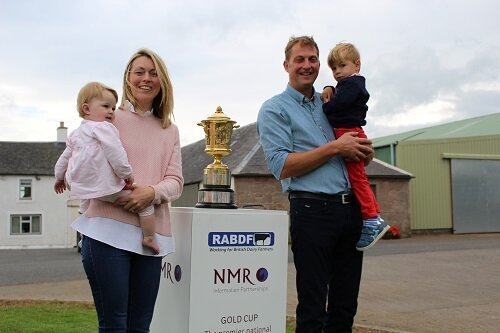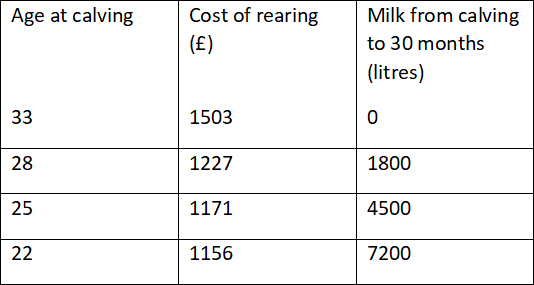Darnlaw Farm was finally able to open its gates to the public after several previous failed attempts at hosting the NMR RABDF Gold Cup Open Day due to the Covid-19 pandemic.
The day was well supported by visitors and trade suppliers and was one of the first face to face events for many in the dairy industry since early last year.
There was positive news from industry commentator Chris Walkland who explained how the market is the most positive it’s been for weeks.
He said: “Butter and skimmed milk powder future prices are heading up, market milk volumes are dropping off fast and are 12-13% lower than at peak, offering the best chance of firming prices.”
The day focused around ‘embracing change’ – a factor that’s been key to the family’s success in creating the progressive dairy business that is at Darnlaw today. By taking the tradition of family farming and adding the latest robotic technology the Sloan’s have ensured the future of their business whilst it has evolved to meet the needs of the wider family by understanding the requirements of a new generation of farm worker.
The provision of a more bespoke milk supply through their Jersey herd has not only helped to increase farm revenue but also the ever-evolving demands of the end consumer.
The 190 pedigree Holstein Master Breeder herd are milked through three Lely robots whilst the 70 cow pedigree Jersey herd are milked conventionally through the farms existing herringbone parlour.
Robert Sloan said: “With the Hosltein herd housed all year round and the Jersey herd grazed in the summer the farm has a unique position of two very different systems running side by side. Our combined aim is to produce milk, but, in an attempt to protect ourselves from price volatility we incorporate diverse income streams to our business and invest in technologies to try and make the farm ever more efficient.
“Our main aim of the day was for everyone to take away at least one piece of information that may help them when they get back home. It’s how we’ve learnt in the past and something I believe is integral to business progression.”
The day hosted four speaker stations, delivered by industry experts, who have been integral in the Sloan’s business development.
Alan Walker and Ed Hewitt from Armour Vet Group spoke on the benefits of looking at the finer details when calf rearing for better herd success:
Getting calves off to a good start is one of the main keys to unlocking the potential in every dairy herd visitors were told by vet Ed Hewitt of Armour Vets.
He said every dairy farm should be aiming for growth rate targets of between 0.7-0.9kg a day for heifers to calve down at 24 months old with this determining the success in dairy herds with heifers calving at 24 months old compared to 26 months or older being found to:
· Have better fertility
· Produce more milk (see table 1)
· Spend longer in the herd
· Have lower rearing costs (table 1)
Calves at Darnlaw Farm are averaging daily liveweight gains (DLWG) of 0.9kgs and Mr Hewitt said it was the farm’s fine detail that was enabling them to achieve such good growth rates.
He said: “It’s important to focus on the fine detail by making sure they receive enough colostrum, are housed in cleaned conditions and are fed correctly to meet target growth rates. These animals are the future of your herd and will determine how successful it is”.
Feed Conversion Efficiency
Mr Hewitt described the first 70 days in a calf’s life as the ‘golden opportunity' for dairy farmers. “The feed conversion efficiency during this period is 50%, meaning it takes 100g of feed to put on 50g of weight. After this time, the efficiency drops and you would need about 1kg of feed to put on about 60g of weight”.
Mr Hewitt said farmers should offer an ad lib calf starter feed to calves, as soon as they are born, alongside milk to get them used to the feed. He also suggested farmers use milk powder instead of cow’s milk to ensure youngstock are receiving a consistent feed that is free from disease.
The amount of milk they receive will be dependent on their size. However, ventilation and temperature should also determine the level of milk fed, explained Mr Hewitt.
“For calves less than three weeks old, you should be adding 50g of milk powder for every 5C drop in temperature below 15C.”
Cleanliness
However, he warned farmers of the importance of maintaining the cleanliness of teats to maintain calf health.
Darnlaw Farm have installed computerised milk feeders from Volac. This allows individual calves to be fed to a set programme, with the machine automatically washing the feed lines daily and the teats between each calf.
Studies show the bacterial count on the teat just after a calf has fed is 117. After a wash cycle, this drops to 37 and if it is never washed, this rises to 2258. Below 40 is the food standard.
“Imagine passing a cup around and everyone taking a drink out of it. If you were the last person to take a drink then there would be a high bacterial load.”
The calves at Darnlaw are reared in pens of 15, vaccinated for a range of diseases including pneumonia and are housed on an all-in-all-out system.
All calves receive an adequate amount of quality colostrum in the correct space of time.
Mr Hewitt said: “Robert measures colostrum quality using a brix refractometer and is looking at levels more than 23. He feeds 10% of their bodyweight in the first six hours of their life.”
Table 1: Comparison of milk production and rearing costs from heifers calving at different ages
Other speakers included Graeme Bryson from William Duncan & Co, Mike Steele from Lely and Agri-King’s Neil Howie. Topics covered how to make robotic farming the right choice for you, accounting automation and the benefits it can bring and efficient nutrition for dairy beef.
Over 50 trade stands were present on the day showing their support for the farm and wider industry. RABDF’s managing director, Matt Knight, said it was great to see so many people turn up to celebrate the Sloan’s winning the Gold Cup.
“With no industry events for almost 18 months it feels great to back, and what an event to kick off with, a day celebrating the very best in dairy. The farm is an absolute asset to not only the family but the whole sector.”
The 2021 NMR RABDF Gold Cup is not being awarded as a result of the Covid-19 pandemic. Instead the 2020 award finalist farm visits will be carried out next month with the winner being announced at Dairy-Tech 2022. The 2022 award will go ahead as normal. For further information please visit www.rabdf.co.uk or call 02476 639317.



